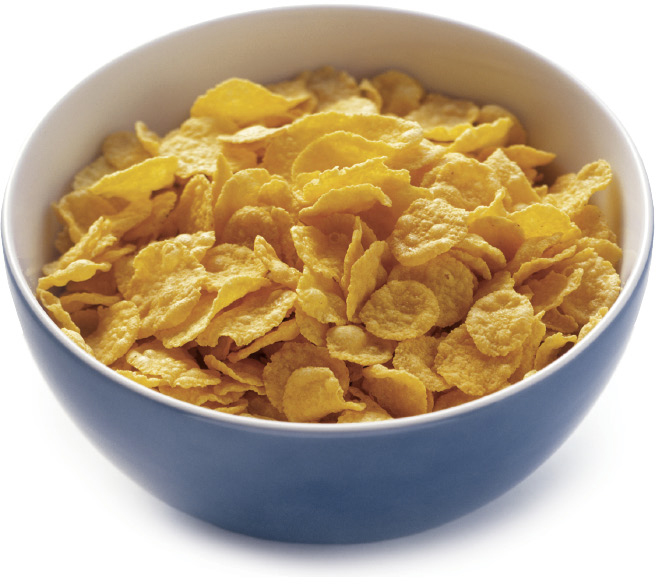
LOW
When you eat grains—and of course, they should be a regular part of your diet—you can’t do better than bran. In fact, a bowl of bran cereal has just one-third the GL of a bowl of cornflakes. (Check out “How Cereals Rate” at right.) That means your blood sugar will go up only a third as much, so it doesn’t have far to fall. (Remember, it’s those precipitous drops that cause trouble and make you hungry again.)
Since bran is one of the three essential components of whole grains (along with the germ and endosperm), we recommend starting your day with bran cereal. Top it with berries, and you’ve really hit your Magic eating stride.
Think of bran as the heavy “overcoat” worn by kernels of whole grain oats, wheat, or rice. It contains the highest concentration of fiber of any part of the grain (12 grams per 1/2 cup for wheat and rice bran; 7 grams per 1/2 cup for oat bran). As you know, fiber helps you feel fuller on fewer calories, smoothing the way for weight loss.
Bran also helps tame those wild blood sugar surges after meals. When researchers gave obese children either a sugar solution or a sugar solution plus 15 grams (about 4 tablespoons) of wheat bran, the kids’ blood sugar levels were much lower when they ate the bran. If you add bran to your diet regularly, you could really lower your blood sugar over the long term—by as much as 22 percent. At least that’s the drop experienced by people in a study who ate rice bran for two months as part of a heart-healthy diet.
Oat bran is high in soluble fiber, which gives it extra power over blood sugar. Adding oat bran to the mix—meaning pancake, muffin, or cookie mix—can significantly change the food’s effect on your blood sugar. Researchers found that for each gram of beta-glucan, the type of soluble fiber found in oat bran, added to snack bars, the Glycemic Index of the bar dropped by 4 points. A lower GI translates into a lower GL—which means a milder blood sugar response after you gobble down the goody. It takes only 1/3 cup of oat bran to provide 1.5 grams of beta-glucan.
As you can tell, we’re big on bran!
Oat bran can bring down high cholesterol and reduce the risk of heart disease, and it has an FDA-approved health claim to prove it. In one study, men who consumed the most wheat bran (about 9 grams per day) were 30 percent less likely to develop heart disease than those who consumed the least (not quite 2 grams per day).
Rice bran can also lower cholesterol, and early research in animals suggests it may help tame high blood pressure as well. The natural oils in rice bran may be the Magic ingredient. Rice bran is also gluten-free, a real plus for people who have a sensitivity to gluten.
Wheat bran may help reduce the risk of colon and breast cancer. And of course, bran helps keep you regular.
Because bran contains oils that can become rancid, be sure to store it in the refrigerator or freezer once it’s been opened. Many bran cereals, on the other hand, contain preservatives that will keep them fresh for several months in the pantry.

 Make meat loaf more Magic by using oat bran or another bran as a binder in place of bread. It will help blunt the effect of the mashed potatoes you eat with it by lowering your blood sugar response to the entire meal.
Make meat loaf more Magic by using oat bran or another bran as a binder in place of bread. It will help blunt the effect of the mashed potatoes you eat with it by lowering your blood sugar response to the entire meal.
 Sprinkle bran flakes on casseroles.
Sprinkle bran flakes on casseroles.
 Use bran in muffin recipes in place of half the flour for muffins that are high in fiber and loaded with nutrients. If you don’t have bran flour on hand, try using bran cereal. Some brands have muffin recipes right on the box. Add fruit and nuts for truly Magic muffins.
Use bran in muffin recipes in place of half the flour for muffins that are high in fiber and loaded with nutrients. If you don’t have bran flour on hand, try using bran cereal. Some brands have muffin recipes right on the box. Add fruit and nuts for truly Magic muffins.
 Start your day with plain bran cereal, hot or cold (look for Quaker and other brands). It’s one of the lowest-GL cereals you can choose.
Start your day with plain bran cereal, hot or cold (look for Quaker and other brands). It’s one of the lowest-GL cereals you can choose.
 Make pancakes or waffles with rice flour and rice bran or try adding different types of bran and experimenting with the taste and texture. Top with fresh blueberries to squeeze in a serving of fruit.
Make pancakes or waffles with rice flour and rice bran or try adding different types of bran and experimenting with the taste and texture. Top with fresh blueberries to squeeze in a serving of fruit.
Instead of Cream of Wheat: Have a bowl of cooked bran cereal topped with dried cranberries or fresh strawberries.